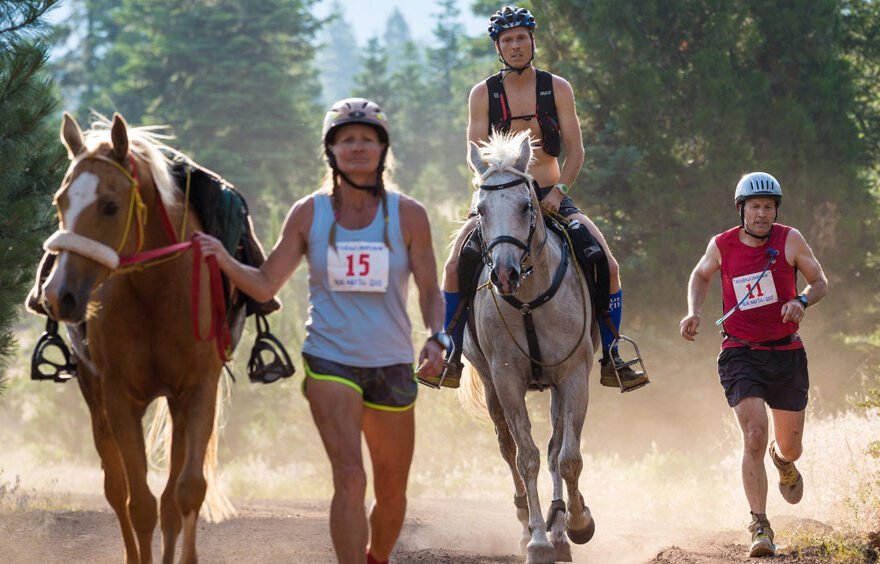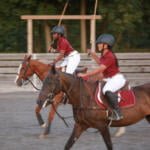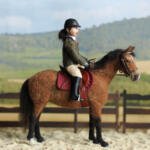Ride and tie is a unique team relay sport that combines horseback riding and running over long distances. But, its appeal runs much deeper than conquering a trail—it’s also a tight-knit and supportive equestrian community that knows how to have fun.
Ride and Tie Association Vice President Sara Boelt met with BRU to explain why this adventurous sport has something to offer for riders of all ages and backgrounds.
This interview has been edited for length and clarity.
BRU: What is ride and tie?
SB: It’s a race with teams of one horse and two people, who take turns running and riding down the trail. The rider and horse will pass the runner, and when they’re ready to switch, the rider will dismount, tie the horse, and begin running. When the first runner catches up, they’ll mount up and take a turn riding, and both teammates continue leapfrogging down the trail until they all cross the finish line.
Depending on the length of the race, you’re required to switch at least six times. You can span that out however you want to, but you have to switch at every tie, and vet checks are considered ties, so if you ride in, you have to run out. There’s no particular percentage that participants have to ride or run. It depends on the team’s preferences and strategy.
BRU: What sort of people seem to enjoy ride and tie most?
SB: It’s really for anybody. I got a lot of my lesson kids involved, and they enjoy it. It’s just a fun, family-oriented, kid-oriented activity. And you don’t have to run. If you want to walk the whole thing, you can. We’ve had endurance riders participate, and sometimes riders talk their running friends into trying it out.
BRU: How did you get involved in ride and tie?
SB: I’ve been a rider all my life, I teach lessons, and I’d done some limited-distance endurance rides before. In 2009, a friend of mine said, “We need to try ride and tie.” I was like, “Are you crazy? I don’t run.” But I agreed. Our first ride and tie was eight miles at Big South Fork in Tennessee. We had a blast, and my horse did great!
We decided to host a race the next spring at Biltmore, in Asheville, NC. My friend is a veterinarian, so she was the vet on duty, and I was the manager. I was hooked after that.
I love the community and the setting. I’m an avid trail rider, and there’s something I just love about getting out on the trails, going to different places, and seeing sights in other parts of the country.
BRU: Tell me more about the ride and tie community.
SB: It’s a small sport, but it’s a group of fun people. People are super competitive, but they also cheer each other on. At the end of the day, everybody is happy and sitting around telling stories. The adults are really supportive of the junior riders.

BRU: How did ride and tie start?
SB: It started in 1971. Bud Johns, who was the public relations person for the Levi Strauss Company out in California proposed it to help market Levis. Back then, they had several hundred riders. There were a lot of people who would wear their Levi jeans or cut them off into Levi shorts to do the ride.
BRU: Do people still do it in shorts?
SB: Yes! In fact, I wear shorts and long soccer socks. I find that more comfortable. A lot of people wear leggings or running tights. There’s one gentleman who has done almost all of the world championships in cutoff Levi shorts.
BRU: What equipment does ride and tie require?
SB: The most important thing is to have a saddle that fits your horse. I did my first ride and tie in my hunt seat saddle, but then I started riding in endurance saddles, and both have worked fine. Everyone has a different tying method, depending on their preferences and their horse’s needs.
BRU: What would you consider to be a good strategy?
SB: It depends. We have a lot of teams with members who are both good riders and good runners, but some teams will have a stronger rider and a stronger runner. Some of the top riders and runners switch every half mile. Some switch every mile, and some do it every fifteen minutes.
In reality, you could switch only twenty feet away from your previous switch. So, if you have a strong runner and a strong rider, that could play to your strengths.

BRU: What skills does a great ride and tie horse need to have? Do they need similar skills as an endurance horse?
SB: I think so. Everyone has their personal opinions on what horse is the best, but any horse can do it. I have Arabians and half Arabians. I also have ponies. They’ve all done ride and tie with me or my lesson kids. I think it’s mostly a matter of conditioning and training. It’s important that they can tie safely.
BRU: What sort of care do the horses receive?
SB: All horses have to do a pre-ride and post-ride vet check, just like an endurance ride. We check them head to tail and especially watch them go for soundness. Depending on the race length, there may be other checks midway. If the horse has anything wrong, you do not complete the ride. If they’re doing well, you continue.
It’s great to have the vets look at your horse. Our vets are awesome. If there’s something weird we’ve noticed on the trail, they’ll really take the time to check the horses for us.
BRU: What are the most common race lengths?
SB: My horses are getting older, and I take my lesson kids, so we stick to the 15- or 16-mile lengths. I’ve done some of the 25s in the past, and a lot of people do the 25- and 30-mile lengths. We have one or two teams who will do a fifty-mile, or a hundred-mile ride and tie. They’re the beasts!
BRU: Do you run and ride many of the same trails as endurance riders?
SB: Yes, we can use the same trails. We collaborate with a lot of endurance events. A lot of the AERC ride managers will include ride and tie along with their races, which is awesome. It helps race managers to get more folks coming.
BRU: Do you get out in some pretty remote areas?
SB: Yes. Some of the camping places we go are pretty primitive. A lot of them are in national forests or state forests. You learn to adapt and take as much with you as you can to be prepared.

BRU: Do ride and tie events mainly happen on the coasts?
SB: There are communities on both coasts. Sometimes it feels like we’re slightly divided—but not intentionally. It’s hard for some of us East Coasters to get out West and the West Coasters to get out here, but a few rides are popping up in the middle of the country. Our hope is that there will be more as time goes on.
BRU: How can people learn more about ride and tie?
SB: They can visit the Ride and Tie Association website. We also have YouTube videos so people can see what an event is like. We’re a small organization, so we’re always trying to get the word out.
A lot of people hear about ride and tie and think, “Oh my gosh, that sounds so crazy. I don’t want to do that.” But, it’s not as complicated as people think it is. I’m always saying this, but it’s honestly just fun! We’re all about promoting ride and tie, and we hope more people will try it out!
If you have a story about how horses or horse people have improved your life, please consider sharing!
Cover photo provided by the Ride and Tie Association.






